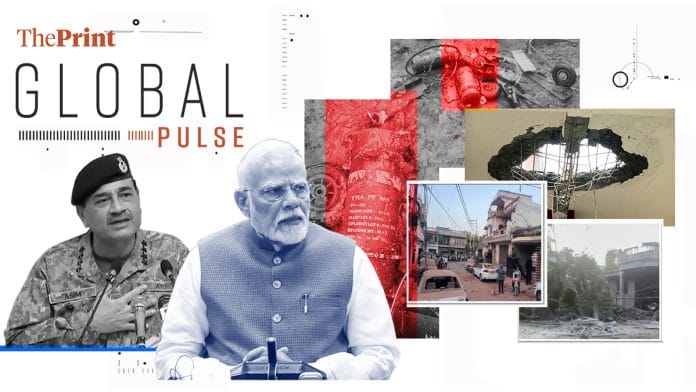New Delhi: The India-Pakistan conflict appears to have escalated dramatically since last night, mutating into the worst stand-off in decades, reported international media.
The confrontation has metastasised into the “most expansive conflict” in decades, reports The New York Times.
“There were widespread accounts of fighting well beyond the disputed Kashmir region, including extensive use of drones, along with gunfire and artillery strikes,” reads the explainer by Zia ur-Rehman, Mujib Mashal, Anupreeta Das and Pragati KB.
The escalation has also used information as ammunition, with The Times also reporting that they could not independently verify either side’s claims.
Another report in The Times also looks at the new weaponry that both have in their arsenal –– drones have been used extensively.
“Although many countries now have drones in their arsenals, this is the first time the unmanned aerial vehicles are being used by the two countries against each other. The use of drone warfare may have been inevitable, but it could reshape the way the world views hostilities between India and Pakistan, much as it did after the two countries became nuclear powers in the 1990s,” it reads.
After Indian missiles struck three key air bases in Pakistan’s Punjab, the latter has said that they will be targeting military sites in India –– drawing the two closer to war, report Shaiq Husain, Niha Masih and Rick Noack for The Washington Post.
Lt Gen Ahmed Sharif Chaudhry, chief of Pakistan’s military information wing Inter Services Public Relations (ISPR), told local news channels that India’s actions were “pushing the whole region toward dangerous war,” guaranteeing a “firm response” from Pakistan, says the article.
Returning to the information artillery, the veil that prevents truth and encourages propaganda, The Washington Post also looks at the fog of war.
“Some of the most significant claims — with Pakistan saying it killed up to 50 Indian soldiers along the Line of Control and India’s defense minister telling political leaders that India killed 100 “terrorists” during Wednesday’s attacks — remained difficult to independently verify,” note Niha Masih, Rick Noack, Karishma Mehrotra, and Shams Irfan in their report.
This one is not your ordinary face-off. The Economist notes that both sides are veering dangerously toward a point of no return.
“They are hitting targets not just in Kashmir, but also in major cities outside it. All this is pushing the two powers into a dangerous cycle of escalation. The risk of a nuclear stand-off is going up,” says the publication.
A deep-dive in The Financial Times places two crucial leaders –– Narendra Modi and General Asim Munir –– side-by-side. During this week’s skirmishes, Modi presented himself as “a man firmly in control,” while Munir has kept “a low profile,” save for hugging a 7-year-old whose family was, according to Pakistan, killed by Indian forces.
“Modi and Munir are now locked in a game of chicken, analysts say. Neither wants a war, but neither wants to blink first,” wrote John Reed and Humza Jilani of the FT.
““Tit-for-tat action is moving both sides to take certain measures that make it difficult for the other side to off-ramp,” Rudra Chaudhuri, director of Carnegie India, tells them.
The Wall Street Journal has also explained the prospect of escalation, noting Kashmir’s centrality to the conflict as well as nuclear armament.
“Both India and Pakistan have nuclear weapons, which analysts said has restrained both sides from escalating to the point of war during past conflicts. India has declared a no-first-use nuclear policy, but Pakistan hasn’t,” says Shan Li in WSJ.
(Edited by Zoya Bhatti)






